<1> The visual text of Thackeray’s Vanity Fair (1848)—composed of forty full-page illustrations, with seventy-seven smaller insets and sixty-seven initials—offers a competing version of the narrative text, employing fashion as a representation of ideology. From ball gowns to uniforms, dress serves as a public discourse through which national identity is performed and national image formulated and disseminated. While the puppet show that brackets the novel’s performances emphasizes the brittle theatricality of the times, Thackeray’s use of dress critiques the racial and gendered aspects of imperial conquest, staged on the domestic scene through the social aspirations of Becky Sharp, Joseph Sedley, and Miss Swartz. These characters who not only make deliberate use of dress as a tool to promote their goals, but more particularly employ the corseted figure to construct their own narratives of empire. As these storied bodies are subject both to contraction (when corseting is applied to achieve a standardizing effect) and expansion (when corseting either fails or is abandoned), all three characters interrogate the mid-century imperial expansion echoed in the novel’s Napoleonic-era historical context. Accordingly, both female and male corseted figures in Thackeray’s illustrations carry imperial military ambitions into the domestic sphere, while un-corseted figures critique conquest and subject expansion to scrutiny. Many critics have devoted attention to Thackeray’s artwork, primarily with the object of relating text to visual image. Among these, Stephen Canham discovers “a clear correspondence between verbal characterization and visual rendering,” while Simon Cooke, in his Victorian Web essay, points out that the images “act as a paratext, repeating and reinforcing the information inscribed in the letterpress” (48). Judith Fisher identifies a pattern of dislocation between images and text that “compels readers to endlessly revise what they have read and seen” (72). I elaborate on both Cooke’s observation and Fisher’s reasoning by calling attention to corseting as a means of imposing a national identity based on self-control, a uniform that could supersede differences of race, gender, and social class, and which is the subject of considerable resistance in Thackeray’s novel. The tension between narrative and visual texts describes standardization as a problematic outcome of expansion and industrialization. As narrator, Thackeray charts the rising and falling fortunes of a range of characters with a knowing but mostly tolerant irony; as illustrator, he uses style to offer a stronger critique of unthinking conformity and institutionalized ambition.
<2> By the end of the eighteenth century, the growing importance of imperialism as part of Britain's national identity appeared in women's fashions that recalled classical Greece and Rome, a style of dress that emphasized a high waistline and flowing skirts of lightweight cotton or muslin that clung to the female body's natural contours. The popularity of this fashion in France complicated this flattering parallel between British and Roman Empires, however, and English minds gradually associated this style with moral laxity and social disorder. A growing atmosphere of political and moral restraint encouraged the reintroduction of the corset into fashions of the 1810’s, as waistlines gradually descended and narrowed. Fashion historian Christopher Breward marks “the gradual militarisation of male dress and the rise of a more sober patrician appearance from the 1750s onwards,” as upper-class men declared their Englishness by refraining from the excesses of aristocratic costume common in the previous century (134).
<3> In practice, both the popularity of military style and the simultaneous re-introduction of the corset contributed to standardizing the human figure, both male and female, in a manner endorsing both the ideology and the advancing mechanical practices of mass production, so that the average citizen adopting fashionable styles unwittingly also embodied an ideology of progress and expansion. Technological advances in mechanization made possible the manufacture of goods of dependable quality, but mass-production also increased demand for raw materials and therefore both implicated the British imperial holdings (India and the West Indies) and supported the military actions (Waterloo) that form the backdrop of Vanity Fair.(1) Whether military or domestic, in practice, the corset defined male and female silhouettes similarly and consistently through the end of the century. As Valerie Steele observes, the similarity between men’s and women’s corsets evident in print advertisements indicates less a cultural interrogation of the distinction between genders than an outward expression of common national goals and values; for instance, the men’s stays often had “military names, such as the Carlton and the Marlboro” (96). This uniformity in silhouette, manufactured as a consumer product purchased by both sexes across social classes, emerges alongside Britain's growing world dominance through the nineteenth century. Thackeray’s illustrations represent and interrogate the blurred distinctions between military and civilian, men’s and women’s fashions, as the corseted body reimagined all British subjects as soldiers active in the conquest of empire.
<4> In its origins, the corset derives from the cuirass, a protective armor for the upper body, originally made of leather and worn only by men in battle. According to British military historian Major R. Money Barnes, as a result of the Prince Regent's interest in military pageantry, the uniform of the 2nd Life Guards was altered to include a cuirass for the occasion of his coronation as George IV in 1820, and by the mid-1800s, several European forces included cuirassier regiments like the Russian Cuirassiers of the Guard (106). Although the cuirass ostensibly could serve a practical purpose, it was most commonly represented as an ornamental feature of nineteenth-century dress uniforms. As a garment, it defines and prescribes the shape of the soldierly male torso, signaling strength and power through the difference between the broad chest and narrow waist by using decorations like epaulets to widen the shoulders and pointed details to draw the eye in a diagonal line from shoulder to waist. The physical power projected by this “bodily rhetoric of honour,” as Michel Foucault describes it, calls attention to the state’s interest in producing (and then mass-producing) a military automaton:
The soldier has become something that can be made; out of formless clay, an inapt body, the machine required can be constructed; posture is gradually corrected; a calculated restraint runs through each part of the body, mastering it, making it pliable, ready at all times, turning silently into the automatism of habit. (135)
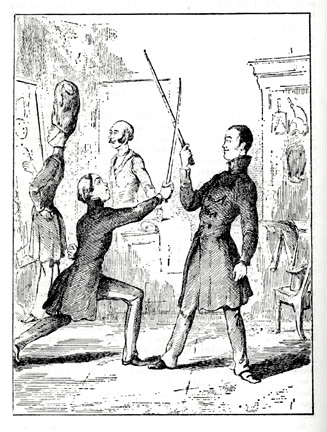
The corseted figure carries this imperial ideology from the military into the domestic sphere, where both male and female bodies can be molded into a single physical form that projects national solidarity, an agreement on the cultural values that signify Englishness, such as moral uprightness (corrected posture) and the self-controlled resolve (“calculated restraint”) prerequisite to expansion. Cultivating this “automatism of habit,” the cuirass or corset becomes central to the embodiment of empire in both military and domestic circles. In the illustration for Chapter 24 (Figure 1), Thackeray represents these aspects of martial masculinity, as the young ensign thrusts his sword at Dobbin, who parries without effort. The male body becomes standardized as it adopts the soldierly uniform and posture displayed by Dobbin in the foreground and the soldier in the background, who is being fitted for his regimentals. As this is an interior scene, set in a shop, Dobbin appears to be defending domestic commerce, while the soldier examining his reflection suggests satisfaction at his transformation from “formless clay.” The scene is simultaneously private and public; Thackeray captures the individual through the playful informality of the hatless young Stubble and Dobbin, while drawing the eye to the standardization imposed by the completely uniformed soldier in the background, admired by the attendant tailor, who, along with the bolt of fabric on the table, reminds the viewer of the important role of commerce as a beneficiary of war. The real resources to be expended are, of course, the soldiers, and Thackeray’s visual text exposes their self-satisfied appropriation of the “bodily rhetoric of honour” as misplaced; in particular, the mock battle and the mirror demonstrate the state’s success in manipulating personal vanity and conformity in the service of imperial expansion (Foucault 135). The postures of all three soldierly bodies are upright, projecting confidence, each defined by the cuirass-shaped narrow waist suggesting athletic fitness, and, further accentuated by the full-skirted military frockcoat.
<5> This hourglass silhouette notably appears in domestic scenes, as well. Becky Sharp and Miss Swartz, both marginalized by gender, nationality, and class, as well as Jos Sedley, marginalized by obesity, employ the corset as part of an invasion strategy conducted through physical and sartorial reshaping, a self-dramatization that underscores the novel’s overt theatricality. The hegemony they seek to infiltrate is that of heterosexual upper-class British masculinity, styled by the cuirass-shaped military male figure that the corset replicates, and their efforts to build personal empires are, in Thackeray’s usual manner, both presented and undercut by their corseted bodies.
<6> Of the forty larger illustrations, the full-length figure of Miss Swartz accompanying Chapter 21 stands out as more distinctly corseted than other female figures, whose waistlines are often obscured by shawls or by sitting postures (Figure 2). Miss Swartz stands facing the viewer, as the Osborne sisters arrange her “amber-colored satin” dress, which occupies their attention; in the background, Mrs. Osborne confers with Miss Swartz’s guardian, who has been bribed by Mr. Osborne to promote George as a suitor (Thackeray 236). Not one of the other women in the illustration looks at Miss Swartz, yet the narrative of her social conquest forms the subject of their thoughts and conversation. Unlike Becky and Jos, Miss Swartz does not perform her own narrative; it is told for her by George Osborne and by the narrator, who confides that “She was reported to have I don’t know how many plantations in the West Indies; a deal of money in the funds; and three stars to her name in the East India stockholders list” (227). Miss Swartz, as drawn by Thackeray, embodies the transformative power of the “bodily rhetoric of honour”; in this illustration, she takes the corseted shape of a typical English lady in elegant dress, commanding the scene despite her very un-English background and personal qualities (Foucault 135). Her economic ties to both East and West reinforce her important role in the circulation of imperial power, a role created in the narrative and underscored by the racially inflected visual paratext.
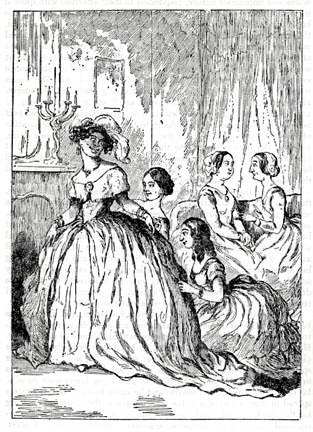
<7> As illustrator, Thackeray employs several techniques to convey Miss Swartz’s racial difference: shading her face so that it stands in contrast to the white complexions of the other ladies, calling attention to the size of her eyes and her broad smile to indicate a lack of restraint visible in the more calculated expressions of the Osborne sisters, and surrounding her face with an abundance of curls (which the narrator calls “wool”) topped with extravagant feathers, unlike the smooth, composed hairstyles of the other women (Thackeray 228). The narrator describes Miss Swartz as “mulatto,” and George reports her father to have been a slave-owning German Jew; her mother’s nationality remains unknown, though the father’s association with the “Cannibal Islands” may indicate Fijian ancestry (229). Through many racially biased remarks, both the narrator and George call attention to her foreignness, the un-English “formless clay” or “inapt body” that must be regulated by the standardizing corset evident in the illustration (Foucault 135). Despite the benefits of an English education, Miss Swartz’s academic attainments and accomplishments remain meager, so that Thackeray may attribute her pending assimilation into English culture solely to her twenty thousand pounds, which stirs the Osborne family. “Ours is a ready-money society,” explains George, and although he mocks Miss Swartz’s elaborately dressed figure and declares, “I’m not going to marry a Hottentot Venus,” his rejection only underlines the fact that, as the illustration makes plain, Miss Swartz’s standardization is accepted as a fait accompli by everyone else (Thackeray 229, 240).(2) As the narrator’s perspective shifts, the reader’s awareness of Miss Swartz’s amiable and genuinely warm nature is complicated by her self-satisfaction at being displayed as the product of imperial success: “Her bejeweled hands lay sprawling in her amber satin lap. Her tags and earrings twinkled, and her big eyes rolled about. She was doing nothing with perfect contentment, and thinking herself charming” (236). Miss Swartz’s indolence and her inability to critique the system that has enriched her at the expense of the slave labor of (perhaps her own) indigenous people, position her simultaneously as both the conquered and the conqueror. Her estate in Surrey and town house in Portland Place, and her connection to the peerage simultaneously evoke and contest English values, since the wealth necessary to acquire and maintain these markers of social identity comes from imperial exploitation. Thackeray’s visualization of Miss Swartz in a smaller 3 x 3” inset (Figure 3), again corseted to represent the modest English gentlewoman at her piano, raises the troubling aspects of imperialism as it creates increasing social mobility and flexibility, a fact the narrator underscores by contrasting her elegant figure and dress with her facial features in repeated references to her racial difference as a “dark paragon,” “Black Princess,” or “Belle Sauvage”—hybrid terms that pair one racial descriptor, negatively inflected in his time, with another describing high status (228, 227). Other images evoke further negative effects of imperial expansion. George calls attention repeatedly to the contrast between her dark complexion and the whiteness of her diamonds, another high-end consumer product associated with exploitation, and the yellow train of her court dress, like the amber satin, evokes the yellow fever associated with the West Indies, from which both George and Dobbin have suffered and from which Rawdon Crawley dies. The circulation of imperial power carries disease, advances the mixture of races, and threatens to dilute European identity through marital alliances for wealth gained by colonial exploitation—powerful critiques of empire Thackeray advances through the visual text, which contrasts her ethnicity with her conformable form.
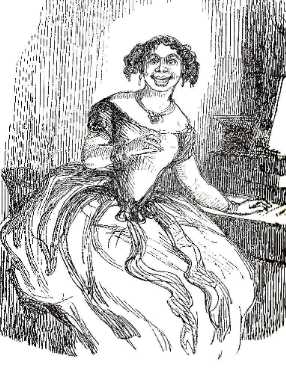
<8> The corseted body pays homage to convention, as standardization offers visual assent to social standards of decorum. From the novel’s opening scene, Becky Sharp performs her fabricated autobiography by dressing the part of the vulnerable noble virgin. Realizing that to enter society she must overcome her parents’ humble origins and dubious morality, Becky characterizes herself as a fallen aristocrat, and frequently alludes to her mother’s upper class French connections. Julia Kent notes that Thackeray was “strongly drawn to French novelistic representations of marriage and domesticity,” which he echoes in Becky’s efforts to gain an establishment (129). Her first narrative of conquest, ultimately fulfilled (economically) at the novel’s close, involves her efforts to secure Jos Sedley, to whom she appears “dressed in white, with bare shoulders as white as snow—the picture of youth, unprotected innocence, and humble virgin simplicity”—a costume that reappears later, in a similar context, when Becky captivates George Osborne at Brighton, where “she looked the image of youthful innocence and girlish happiness” (Thackeray 30, 276).
<9> In Thackeray’s illustration for Chapter 25, “A Family Party at Brighton” (Figure 4), Becky’s corseted figure stands in a pose similar to Miss Swartz’s, one arm gracefully extended to grasp the balcony rail, but Becky stands behind the doorframe to conceal her true intentions from the party in the background, particularly Amelia, who looks on with passive concern from an interior armchair as Rawdon and Jos gamble in the mid-ground, creating a visual dialogue in which duplicities of various types—seduction, swindling, and infidelity—advance the theme of conquest. Here and elsewhere, Becky wagers that she can mask her real motives by adopting the outward trappings of female modesty and gentility prized by her society, but Thackeray’s illustration shortens Becky’s legs in a curtsy, so that she appears crouched against the railing, suggestive of her weakened position later in the novel when her ambitions of conquest have largely been defeated and her narrative of noble descent ceases to convince. Perched on an area that is little more than a ledge, with an elaborate balustrade that lacks protective supports, Becky and George appear in a precarious position; several visual elements carry the viewer’s eye downwards—the point of her bodice, echoed by her neckline as well as George’s vest and tight evening pants—and predict a fall. In this case, the visual paratext goes further than the narrative, foregrounding the pending infidelity that Becky’s white corseted form seemingly belies.
<10> Although most critiques of the novel’s preoccupation with aggressive social maneuvering focus on Becky Sharp, Joseph Litvak’s discussion of Jos Sedley equally affirms the contested meanings of gender, as he points to Jos’s obese body as it undercuts “normative masculinity” in the novel (236). Sandy Morey Norton reads the novel as an intertwining of two narrative strands, one gendered and one colonial, while Christopher Lindner sees Jos’s preoccupation with fashion as part of Thackeray’s criticism of Victorian consumerism.(3) I would like to draw together these valuable lines of commentary by suggesting the ways that body shape contributes to our understanding of the “narrative empires” both Jos and Becky build through the course of the novel, an enterprise that eventually draws them together at the novel’s close. Thackeray describes the corseted and un-corseted figures of both Jos and Becky in scenes that show their respective efforts at conquest.
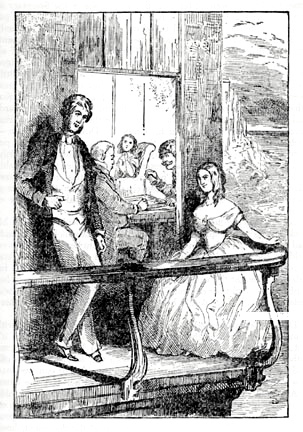
<11> The narrow waist signaled athletic fitness, youth, and virility for Victorian men; in the novel, we learn that to attain these martial masculine virtues, Jos Sedley “had tried, in order to give himself a waist, every girth, stay, and waistband then invented. Like most fat men, he would have his clothes made too tight, and took care that they should be of the most brilliant colours and fashionable cut” (Thackeray 29). Jos’s obesity, however, causes him deep anxiety, emasculating him despite his financial success as an instrument of empire, the ex-Collector of Boggley Wollah, and Thackeray points to his unsuccessful efforts at corseting to underscore both his personal lack of restraint as well as his waste of resources. As collector, Jos is responsible for receiving imperial revenues, and he gains both size and wealth as a consequence of the remoteness of his outpost, Boggley Wollah—on the one hand, administrators must be paid more to undertake the isolation of such a post and to maintain British identity despite “scarcely seeing a Christian face except twice a year,” and on the other hand, the isolation limits opportunities for Jos to spend his salary, other than by indulging his appetite (28). He therefore returns to England to be treated for a liver complaint, intent on conquering fashionable society with a series of invented stories that magnify the importance of his imperial role.
<12> In contrast, the narrator catalogues the ridicule Jos experiences at home when he returns to London, “where the jokes of his good-natured father frightened his amour-propre” and make him “inclined to be a parricide almost” (Thackeray 29, 36). He first impresses Becky with his “tiger-hunt” story, but these fictionalized accounts of manly bravery are insufficient to combat his status as the “monster” his father labels him, further excluding him from masculine privilege. Jos counters this criticism of his obese body by creating alternative autobiographies in which he features as the intimate of celebrated public figures—to combat his father’s ridicule, Jos would “talk of this period of his existence with great enthusiasm, and give you to understand that he and Brummell were the leading bucks of the day” (29). Contemplating marriage to Becky, he recalls and attempts to retell a favorite story of romantic conquest in which he was the matrimonial object of one Miss Cutler of Dum Dum. Later in the novel, Jos creates another, more stately narrative empire that earns him the nickname “Waterloo Sedley,” falsely insinuating not only that he was a combatant at Waterloo, but also that he was present at Napoleon’s surrender and imprisonment on Elba, thus asserting a military masculinity at odds with his feminized corpulence. Mary Hammond describes the Waterloo section of the novel as a moral site where “national identity blurs….The battle is the locus for the performance of imperial self-interest as national pride” (35). Jos appropriates the battle as part of his Englishness as well as his masculinity, which becomes increasingly performative as the novel progresses. Thackeray’s illustrations featuring Jos employ body shape to comment on the national identity proposed by imperialism and disseminated through fashion.
<13> In addition to corseting his excessive waistline, Jos devotes great attention to his grooming before he appears in public, which Lindner views as an “amalgamated expression of unrestrained, even unrestrainable consumerism” (572). However, this impulse has a broader motive—the conquest of fashionable society, which is at the heart of Jos’s autobiographies associating himself with the famous and privileged, and which links him with Becky. Thackeray describes Jos’s preparations for public appearances in feminized terms: “He took the hugest pains to adorn his big person, and passed many hours daily in that occupation. His valet made a fortune out of his wardrobe; his toilet-table was covered with as many pomatums and essences as ever were employed by an old beauty” (Thackeray 29). Joseph Litvak reads Jos’s use of cosmetics as evidence of his “problematic relation to the norms of middle-class heterosexual masculinity” (223), but Thackeray observes that men, “the bearded creatures,” are just as susceptible to personal vanity “as any coquette in the world” (30). In a study of Thackeray’s dandies, M. Lambert agrees that these characters “exemplify his dislike for the excesses which these devotees had reached by the 1840s” (64). Jos’s corpulence, displayed by tight clothing and bright colors, performs the “other” male body as a landscape of excess that must be subdued by corseting and rendered attractive by cosmetics. Like Becky, his sexual urges are less physical than they are social—he desires a prominence at odds with the emasculated status assigned to his obesity.
<14> For his part, Jos labors to sustain a counter-autobiography that asserts his expanding social status and sexual desirability through a compressed, corseted waistline. The illustration for Chapter 4 entitled “Mr. Joseph Entangled” (Figure 5) pictures Jos and Becky seated in the parlor, Jos holding some silk in his hands as Becky winds it. She leans towards him, drawing the silk taut, while he leans back in his chair to accommodate his protruding midriff, balanced visually by the expanse of Becky’s skirts; his obesity indicates his wealth, which she tries to reel in and control by drawing the skein in with her fingers, much in the posture of Thackeray’s puppet-master. The drawing emphasizes Jos’s portliness, calling attention to Becky’s efforts to ensnare him, and the title casts him as her prey, testing Mr. Sedley’s remark that “the first woman who fishes for him, hooks him”; the domestic setting further contrasts him with the other males in the novel, who are not only slender, but also generally depicted in uniform in aggressive, standing postures, often brandishing swords, as in the illustration “Ensign Stubble Practises the Art of War” (Thackeray 37).(4) As Jos sits passively, his boots tucked suggestively under her expanding skirts, Becky appears to be in the process of enveloping him, an act of “subliminated aggression” (Capuano 167).(5) Having successfully invaded the Sedley household, Becky intends further infiltration and conquest of the middle class by marrying Jos; she employs a white dress to portray the virginal innocence she believes will best ensnare him into proposing. Her objective is defeated in part by Jos’s anxiety about his girth, which Mr. Sedley exacerbates by publicly exposing Jos’s obese body to insult. Although Becky’s waist is obscured, her arm and elbow form an angle that approximates the corseted shape, in direct contrast to his convex rotundity.
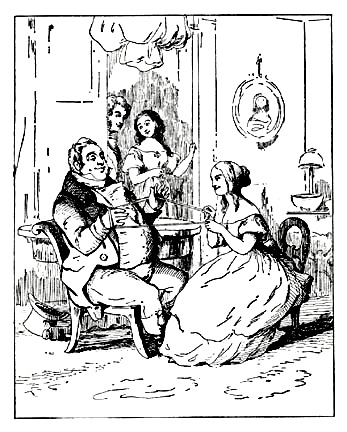
<15> The visual text again progresses the narrative treatment of empire-building, as it underlines the process of circulating wealth and reproducing ideology. Unsuccessfully corseted, Jos’s belly displays his success in converting British influence in India into personal comfort and wealth, which he has (for the moment) returned to spend at home in England; Becky attempts to acquire that wealth by playing the role of decorous virgin, which her corseted form and white dress confirm. Matrimony and domesticity are contemplated by all four characters in the scene, and the luxuries of the Sedley home have been provided by British commerce, furthered by trade and imperial conquest. Through the domestic interior setting and the figures of the engaged lovers in the background, Thackeray further emphasizes the English home as the reproductive center of the nation—not only in its natural engendering of future subjects but also in its capacity to disseminate an ideology justifying English expansion abroad.
<16> Jos’s excessive male body acts as a contested signifier of imperial desire in the narrative, as well; as ex-Collector of Boggley Wollah, his waistline expands in acts of masculine consumerism and consumption that link personal appetite to the military conquest of territory, but it also contracts somewhat—notably by enforced corseting—and disrupts the imperial prerogative by deflating its martial masculinity. Since “a big belly was associated with English cultural nationalism,” Jos’s obese body at first appears to be dedicated to an ever-expanding urge for consumer gratification (Steele 233). However, Jos’s portliness exceeds the acceptable bounds of masculinity in the novel. As excessive Other, Jos and his girth must be restrained by corseting to conform to the standardized image of male virility ideally embodied by the soldier in Vanity Fair. Thackeray emphatically points to Jos’s physical difference from other males, particularly the slender Dobbin and George Osborne, who serve as Waterloo combatants while Jos idles, fretting at his stays, emasculated and immobilized equally by his obesity and by the corseting that calls his heterosexuality into question for his father. Mr. Sedley openly mocks Jos’s masculinity and links his weight to his imperial role, ridiculing his son’s discomfiture:
“Undo his stays!” continued the pitiless old gentleman. “Fling some water in his face, Miss Sharp, or carry him upstairs; the dear creature’s fainting. Poor victim! Carry him up; he’s as light as a feather!”
“If he stand this, sir, I’m d—!” roared Joseph.
“Order Mr. Jos’s elephant, Sambo!” cried the father. (Thackeray 36)
Mr. Sedley refers to Jos as a fainting female here not only to deflate his son’s vanity, but also to make him a less attractive prospect to Becky by linking his obesity with effeminacy.
<17> By ordering the hyperbolic elephant, he also associates Jos’s weight with his position as colonial collector; the elephant as a symbol of India becomes inextricably linked with Jos in the novel, as George Osborne later sneers that since Jos follows his military unit like a mascot, its standard should be the elephant. In Becky’s initial fantasy of marrying Jos, she imagines herself riding an elephant in an Indian procession to the sinister march from Bluebeard. And, finally, the painting of Jos riding an elephant surfaces several times in the novel to point to Becky’s desire for imperial wealth; she purchases the painting at the sale of the Sedley household effects and later uses it to convince Jos of her constancy after many years, which causes him to name her beneficiary to his insurance policy. Mr. Sedley’s reference to Jos’s stays pointedly feminizes him, contradicting his masculine imperial identity as immobilized by “super-abundant fat” and replacing it with a domestic passivity (29).
<18> Despite his advantages as a male member of the monied class, Jos must work hard to infiltrate the dominant order by performing a military form of masculinity. Accordingly, Jos moves swiftly to adopt a military style of dress and bearing once war appears imminent. At Brighton, Jos appears in a costume that replicates elements of the masculine hegemony he wants to infiltrate:
He sported a military frockcoat, ornamented with frogs, knobs, black buttons, and meandering embroidery. He had affected a military appearance and habits of late; and he walked with his two friends, who were of that profession, clinking his boot-spurs, swaggering prodigiously, and shooting death-glances at all the servant-girls who were worthy to be slain. (246)
Jos’s performance of the soldierly body employs an imperial strategy, as he attempts to infiltrate this unquestionably masculine society by adopting military-inspired dress, appearing in public in the company of soldiers, and leering at women who are only symbolic objects of desire since they belong to a lower social class. He grows a military-style mustache, learns “as many military names as he could,” and accompanies the train of female followers to Brussels, where “he made his appearance in a braided frock-coat and duck trousers” and is mistaken for “a great personage” (310-11). However, once a French invasion seems imminent, Jos swiftly abandons both his military dress and his obligations as male protector to flee the country. Later in the novel, he resumes a military-inspired costume in the illustration for Chapter 63, “Jos Performs a Polonaise” (Figure 6), but Thackeray undercuts his efforts at martial masculinity by visually comparing him to two tightly corseted figures, the military gentleman of clearly corseted waist as well as Jos’s partner, the Countess of Schüsselback. Thackeray highlights the visual contrast by drawing Jos in silhouette, so that his profile can be compared with that of the elderly soldier behind him; his costume, a pastiche of military and evening attire, belongs properly to neither. Jos’s face, arm, waist, and leg appear as obese parodies of the soldierly form, and by drawing him in the military-inspired frock-coat, Thackeray cautions the viewer that, as with Becky, sartorial reshaping can produce counterfeits. His drawings of Jos reveal the “scorn for military glory and patriotism” evident in the 1841 Fraser’s essay “On Men and Coats,” where he writes, “Accursed, I say, be all uniform coats of blue or of red; all ye epaulets and sabertashes; all ye guns and muskets . . . What business have I to plume myself because the Duke of Wellington beat the French in Spain . . . and fancy myself to be of heroic stock because my Uncle Tom was at the battle of Waterloo, and because we beat Napoleon there?” (Carey xxix; Thackeray 376). In both text and illustrations, Thackeray shows his contempt for the sham heroism proclaimed by Jos’s faux uniform, scrutinizing the standardizing impulse of fashion, particularly when it serves as the tool of ideology.
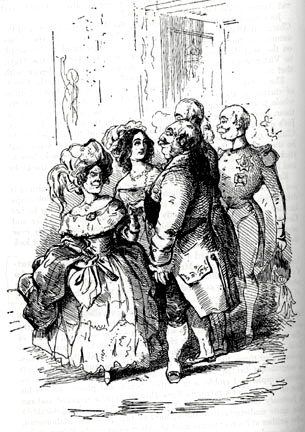
<19> Dress and duplicity share a long history, however, and Thackeray’s illustrations point to fashion’s manufactured uniformity as an expression of national values—in this case, military ambition recast as patriotism, filtering into civilian life through popular style. Costume historian Norma Waugh remarks that although the frock-coat favored by Victorian men may appear to modern viewers to imitate a feminine silhouette, the shape “was probably of military origin . . . the body was always fitted—first dart then seam at waist, and the skirts—very full—hung straight down from the waist centre front” (113). In civilian life, men of the mid-century depended on their tailors to create this look through “the skillfully cut and artfully padded coat, vest, and trousers that transformed the average masculine body into the desired hourglass shape” (Kidwell and Steele 127). Fashion historians Claudia Kidwell and Valerie Steele describe the use of padding in men's suit coats to illustrate the similarity in male and female silhouettes of the period:
The padding in this garment started at the shoulder and extended into the sleeve to maintain the desired broad, sloping shoulder line that smoothly curved into a full arm. The padding also flowed from the shoulder over the chest and down and around the body—particularly adding breadth under the arms—then thinning to nothing at the waist . . . The cutaway skirts of the more formal dress coats were padded and eased into the waistline to produce a full rounded hip shape. A man's waist, located between the padded shoulders and chest above and the fullness below, looked small by contrast. (128)
The narrow waist signified athletic fitness and youthful vigor for Victorian men, some of whom resorted to corsets as a defense against time, weight, and sagging muscles. Fashionable tailors of the period were naturally associated by trade with stay-makers, as “stays were considered to be a branch of tailoring” and, since most eighteenth-century stays were made using whalebone, or baleen, stay-makers were usually men and their trade depended on the male-dominated whaling industry, which was chiefly conducted in foreign waters (Sorge 18). Stays were widely accepted, if noticeable, garments for men in public life. C. Willett and Phillis Cunnington include among male corset-wearers such well-known Victorian figures as Bulwer-Lytton, “who was labeled by Tennyson as ‘the padded man who wears the stays’” and Disraeli, “whose stays were visible though the back of his coat” (127).
<20> Through Jos’s unsuccessful corseting, also evident at a glance, Thackeray suggests the consequences of unregulated imperial desire, and he presents Jos’s obesity as a visual reminder of waste—the wealth he amasses in India does not, after all, return to enrich England. A creature oscillating between masculinity and femininity, as between the metropole and the outpost, Jos never considers buying property in England, which would be the next logical step in his family’s social advancement, as Miss Swartz knows well. From an imperial standpoint, his wealth is wasted, dissipated among Continental watering-places, where he lolls as an unproductive “Citizen,” as the narrator ironically titles him. He becomes Becky’s prey at the novel’s close, as she too embodies unregulated desire when, at the apex of her social ascent, she plays the role of Clytemnestra in a charade for the English Court in Chapter 51. Thackeray’s illustration, “The Triumph of Clytemnestra” (Figure 7), shows Becky uncorseted after the performance, wearing a low-cut Grecian-style costume, the long dagger still in her hand. She curtseys to Lord Steyne, who bows as though they are dancing partners, acknowledging a mutual skill at social maneuvers. By presenting Becky’s unmolded form, Thackeray visually locates her outside the boundaries of self-control and social propriety embodied by corseting, whether military or domestic, and her convincing portrayal of premeditated murder equally shocks the audience: “Rebecca performed her part so well, and with such ghastly truth, that the spectators were all dumb” (Thackeray 598). The illustration further points to her marginality as potential criminal by contrasting her figure with the shape of the lady in the background, who is appropriately attired in cloak and bonnet; Becky’s true, transgressive nature emerges once she casts off the standardized form that signifies female virtue. As she enacts the crime of husband-murder, her own ambition emerges as a parody of the national ideology of expansion, as she infiltrates society and attempts to control the male agents of imperial conquest: the military (Rawdon), the aristocracy (Lord Steyne), and the colonial administration (Jos). By drawing her uncorseted and dangerously armed as she confronts the peerage, Thackeray offers “a probationary sympathy to Becky’s ambition” while censuring the privileged classes that fostered her desire (Fletcher 383). However, the charade’s classical source, Aeschylus’s Agamemnon, also associates domestic violence with injustices committed in the name of empire, as it treats the sexual oppression of native females by colonial males. In this illustration, Thackeray also includes the English actors playing the first scene in the charade, a veiled slave-girl “in gorgeous oriental costume” presented to “A Turkish officer with an immense plume of feathers,” marking the importance of cultural appropriation by dress as a powerful means of asserting English national values by exerting control over the Other (Thackeray 596). The widely-held belief that uncorseted women were loose and immoral continues in the final illustration, which shows Becky concealed behind a curtain as Jos communicates with Dobbin; again, she is uncorseted and holding a dagger, and the threat implied by this combination has formed one explanation of Jos’s untimely death shortly after this episode, confirming the prevalent “fear of unrestrained women” (Fields 357).(6)
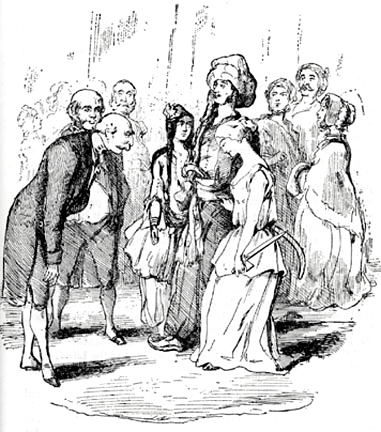
<21> By the time Vanity Fair appeared in 1847, the corseted silhouette could be observed equally in civilian and in military fashion, suggesting the increasing national importance of a common desire for power and authority, a respect for self-control and discipline, and a belief in a unified imperial identity. Both male and female wearers in the novel employ the corset as an instrument of power, a uniform sign of national consensus necessary to disseminate English standards throughout the world. Thackeray exploits this view of the malleable body in Vanity Fair to examine the British pride in self-conquest implicit in both military discipline as well as in domestic order, and he uses dress to scrutinize the imperial impulse, illustrating both corseted and un-corseted figures to examine the moral implications of standardization in a growing consumer culture based on colonization and mass-production. In this endeavor, his illustrations form a paratext that not only complements the narrative, but also offer a significantly harsher criticism of both the goals and the consequences of allegedly patriotic expansion. As intermittent visualizations of ongoing narrative strands, the illustrations point to moments Thackeray as author/illustrator particularly wants to emphasize, and because they take visual form and can include both foregrounded and backgrounded elements, he can incorporate subtle details to progress the novel’s acute social analysis. In the Vanity Fair illustrations focusing on corseted figures, Thackeray as illustrator disparages jingoism by representing military-inspired fashions as a means of naturalizing and disseminating imperial ideology to unwitting civilian consumers.
